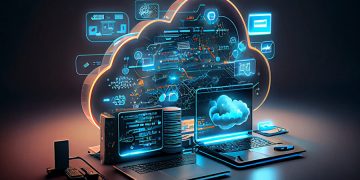As we stand on the precipice of a new era in computing, the future of technology is not defined merely by faster chips or larger networks. The next frontier of computation involves systems that not only process data but understand it, adapt to it, and evolve in response to it. This vision of the future is embodied in the concept of cognitive infrastructure — computing systems that are not only intelligent but capable of learning from their experiences, making decisions in real-time, and optimizing their performance without human intervention.
Today, we already see glimpses of this future. From AI-driven data centers to self-optimizing algorithms in cloud computing, the foundations of cognitive infrastructure are being laid. But to truly unlock the potential of intelligent computation, we must rethink how we design, deploy, and manage computational systems. This article explores the emerging world of cognitive computing, how it will transform industries, and the implications for both technology and society.
From Systems to Self-Learning Machines
Traditionally, computing systems have been designed with a clear distinction between hardware and software. The hardware — whether it’s a CPU, GPU, or quantum processor — provides the raw processing power, while the software runs on top of it, performing specific tasks according to predefined instructions.
However, this model is increasingly insufficient in the face of modern computational demands. As machine learning models grow more complex and data volumes continue to explode, the need for systems that can dynamically adapt to changing workloads and optimize their own performance is becoming more pressing. In response to this challenge, we are beginning to see the rise of self-learning machines — systems that can optimize their own processes, manage resources, and even predict future needs.
Self-learning systems are already being implemented in areas like cloud computing and AI infrastructure. For example, Google’s DeepMind has demonstrated how AI systems can be used to optimize the energy consumption of data centers, reducing the power required for cooling by over 40%. This type of self-optimization is just the beginning. As machine learning systems become more integrated into the very fabric of computing infrastructure, we can expect the lines between hardware and software to blur. The goal is not just to build a system that can compute faster, but one that can compute smarter.
Real-Time Decision-Making: The Role of AI in Cognitive Infrastructure
In cognitive infrastructures, AI does not merely process data; it makes decisions based on that data in real-time. These systems will be able to autonomously adjust their resource allocation, identify inefficiencies, and even predict potential failures before they happen.
A key enabler of this is the development of AI-driven orchestration systems, which manage and optimize the performance of distributed computing resources. These systems use advanced machine learning models to continuously monitor performance, predict demand, and make adjustments accordingly. This is similar to how a self-driving car constantly processes sensor data and adjusts its actions in real time to navigate safely.
In the context of cloud computing, AI orchestration systems can allocate resources based on predicted workloads, ensuring that servers are used efficiently and that tasks are assigned to the right computing resources. For instance, a cloud provider may use machine learning to predict usage patterns for different applications and proactively move workloads to the most appropriate servers, reducing latency and improving performance. These systems can also detect anomalies in performance and automatically reconfigure resources to address issues, reducing downtime and improving the overall user experience.
The potential of AI-driven infrastructure goes beyond just optimization. These systems can also enhance security, by autonomously detecting threats and mitigating them without human intervention. For example, AI-powered cybersecurity systems can continuously scan networks for suspicious activity, identifying patterns and anomalies that may signal a breach. The system could then take action, such as isolating compromised nodes or blocking malicious traffic, without waiting for a manual response.
The Power of Predictive Analytics in Cognitive Computing
At the heart of cognitive infrastructure is predictive analytics — the ability of systems to use past data to forecast future events and optimize decision-making. Predictive analytics has already transformed industries like retail, healthcare, and finance, where it’s used to forecast customer behavior, identify health risks, and predict stock market trends.
In the context of cognitive computing, predictive analytics takes on an even more critical role. Rather than just identifying trends, predictive systems will anticipate the future needs of the infrastructure itself. For example, an AI-powered data center might predict spikes in traffic before they happen, adjusting power and cooling resources in anticipation. It could also predict hardware failures based on historical data, proactively scheduling maintenance before a problem arises.
Moreover, predictive analytics will enable new levels of automation. Imagine a self-learning system that knows not only how to handle existing workloads but can also anticipate new workloads before they arrive. For example, during a large-scale machine learning model training, the system could predict the exact amount of GPU power needed based on prior experience, automatically provisioning additional resources if necessary. This level of predictive insight could lead to more efficient systems, lower costs, and better overall performance.
Distributed Intelligence: The Future of Networked Systems
While self-learning algorithms and predictive analytics are essential for cognitive computing, the future of cognitive infrastructure will not be limited to a single centralized system. As the internet of things (IoT) continues to grow, we will see the rise of distributed intelligence, where cognitive systems are embedded throughout networks of connected devices, each capable of learning and optimizing independently.
This concept is already emerging in the form of edge computing, where data processing occurs closer to the data source, rather than relying on a central data center. Edge devices, such as sensors, drones, and IoT devices, will increasingly possess their own cognitive capabilities. These devices will be able to process data locally, make decisions based on that data, and communicate with other devices in the network to optimize performance.
For instance, in smart cities, traffic lights could autonomously adjust their timing based on real-time traffic conditions, reducing congestion and improving traffic flow. In manufacturing, smart machines could predict when maintenance is needed and order replacement parts automatically, minimizing downtime. This decentralized, intelligent infrastructure would allow for highly adaptive and scalable systems, capable of operating autonomously across vast networks.
The integration of edge computing with cognitive infrastructure will also lead to better resilience. Distributed systems are inherently more robust than centralized ones, as they can continue to function even if parts of the network go offline. This is especially important for applications like healthcare, where real-time data processing and decision-making are critical, or for autonomous vehicles, where split-second decisions are needed to avoid accidents.

Ethical Considerations in Cognitive Infrastructure
While cognitive computing promises to revolutionize the way we manage and use computing resources, it also raises important ethical and societal questions. As systems become more autonomous and self-optimizing, the line between human and machine decision-making becomes increasingly blurred. Who is responsible when an AI-driven system makes a wrong decision? How can we ensure that these systems are transparent and accountable?
One of the biggest challenges will be ensuring that cognitive infrastructure remains aligned with human values and goals. As AI systems make more decisions on their own, we must ensure that they do so in ways that are ethical, fair, and equitable. This will require ongoing research into AI governance, ethical guidelines for autonomous systems, and robust oversight mechanisms.
Additionally, as cognitive infrastructure becomes more ubiquitous, it will be critical to address privacy and security concerns. With self-learning systems continuously processing data and making decisions, there is a risk that sensitive information could be misused or exposed. Ensuring that these systems operate with privacy and security at the forefront will be crucial to their success.
The Road Ahead: Cognitive Infrastructure in the Real World
The idea of cognitive infrastructure is still in its early stages, but the potential impact is profound. In the near future, we will see the first practical implementations of self-learning, AI-driven systems in industries such as finance, healthcare, energy, and telecommunications. These systems will not only be more efficient but more adaptable, enabling organizations to meet the ever-growing demands of the digital age.
However, the road to cognitive infrastructure will not be easy. It will require the integration of diverse technologies, such as AI, machine learning, edge computing, and quantum computing, into a cohesive system. It will also require collaboration across industries, governments, and academia to address the technical, ethical, and societal challenges that come with these advanced systems.
Ultimately, cognitive infrastructure represents the future of computing — a future where systems are not just tools, but partners in problem-solving, optimization, and decision-making. In this future, computers will do more than just process data; they will think, learn, and evolve with us, providing intelligent solutions to the complex challenges of our time.












































